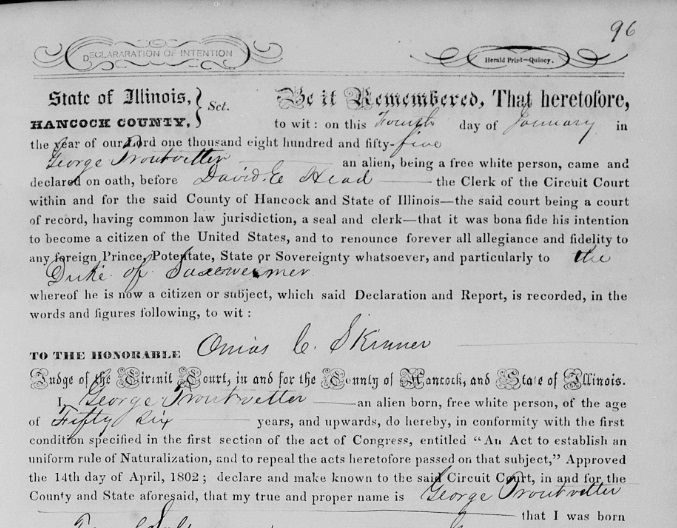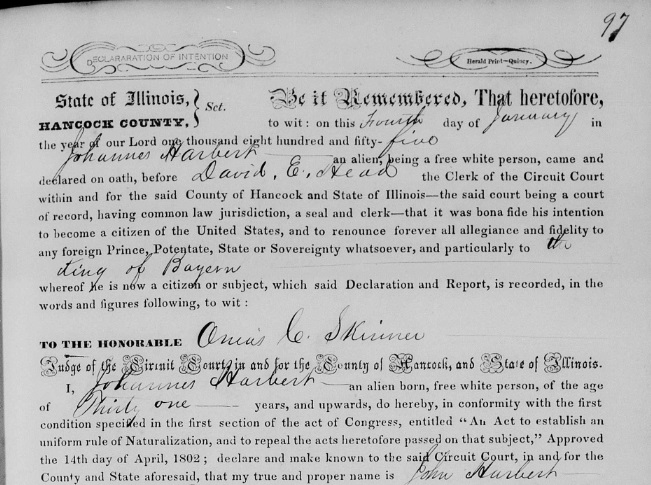The declaration of intention for George Trautvetter was one of those documents I located early on in my research, probably before I was able to even drive myself to the courthouse.
I did not take the time to look at the other declarations in the book. After all, I had found the person I wanted and I was excited at the discovery I had made. The declaration gave George’s date and place of birth along with his immigration information–the illustration only shows part of the document. I knew to be skeptical in regards to the accuracy of the information it contained and to use to to further my research, but I didn’t think to leaf through the other declarations in the ledger.

Declaration of Intention, George Troutfetter, Declarations of intention 1852-1858 vol 2, Hancock County, Illinois, Circuit Clerk, p. 96; digital image, FamilySearch (http://www.familysearch.org), downloaded 11 May 2016.
I should have. There on the next page was another declaration made out on the exact same day (4 January 1855) for Johannes Herbert. Herbert was born in a different region of Germany, but he was related to Trautvetter.
He was his son-in-law and had married Trautvetter’s daughter in Germany before the family immigrated.

Declaration of Intention, Johannes Herbert, Declarations of intention 1852-1858 vol 2, Hancock County, Illinois, Circuit Clerk, p. 97; digital image, FamilySearch (http://www.familysearch.org), downloaded 11 May 2016.
The proximity of the declarations in the book makes an excellent point about a type of “neighbor” researchers don’t always think to look for: paper neighbors.
People who appear in court on the same day, doing the same thing, and who had to travel a distance to do it, could have some connection to each other. The documents will not necessarily state that relationship; these records certainly have nothing to say about the connection between Trautvetter and Herbert.
It is always good methodology to think about what caused your ancestor to appear in a record and if it is possible that other people he knew may have appeared in that series of records as well. The clue would have been a little stronger if Trautvetter and Herbert had been from the exact same area of Germany and had owed allegiance to the same ruler, but that’s not the way things always work out.
Other paper neighbors of our ancestor are often used as clues–nearby names on a census or tax list indicate geographic proximity as do other records.
The Bureau of Land Management tract books are another excellent place to learn of more paper neighbors. Certainly the geographic nature of that index makes physical neighbors easy to spot. But there’s more.
The tract books indicate dates an initial claim was filed in the nearest land office. Which of those geographic neighbors are filing claims at the same time as your ancestor? If there are others filing the same day, they may have more of a connection to your ancestor than simple geography. Those “paper neighbors” may be worth looking into.
I certainly wish I had turned the page in that book of declarations of intention all those years ago when I first located George.

4 Responses
Michael, If the name is not known at the time as being related (married into) should a person make a note regarding the name(s) or copy the documents “on the chance that” you may find a connection in the future? There could be a couple of neighbor families coming over together.
Yes, I’d make a note about others who made their declarations or naturalized on the same day—especially if they were from the same foreign country. If there are a LOT of them on the same day, it could be a way to get more voters. But in most cases there aren’t all that many making these statements on the same day, especially outside of urban areas.
You are so right! I have found 2 sets of Great Great Grandparents with the help of the Census records. And I have found hints for other relatives.
You always have interesting articles. Thanks, Laura Adams
You are welcome! I’m glad you enjoy them.
Michael